KÃsÃĐrleti epidemiolÃģgiai mÃģdszerek
0 likes145 views
KÃsÃĐrleti epidemiolÃģgiai mÃģdszerek
1 of 21
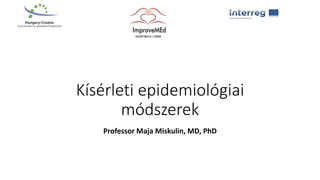

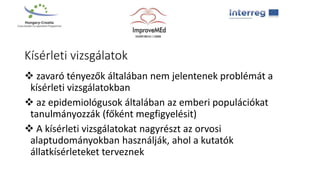
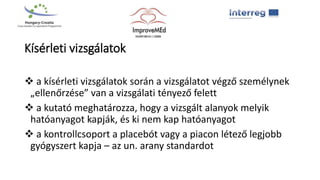
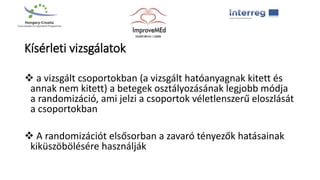
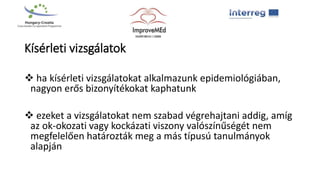
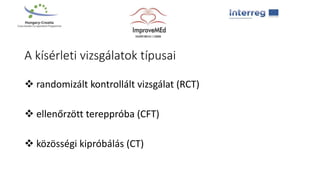
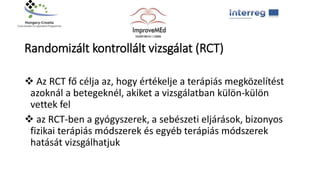
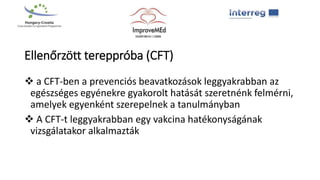


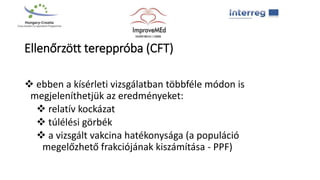

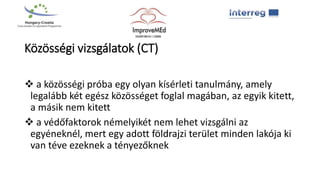
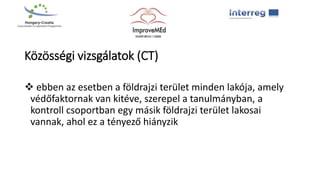
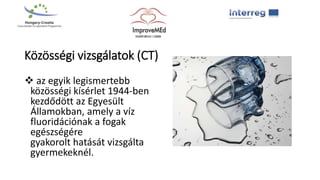
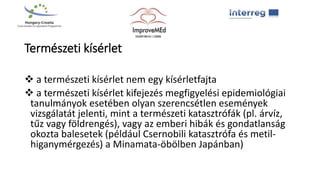
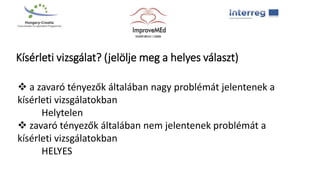
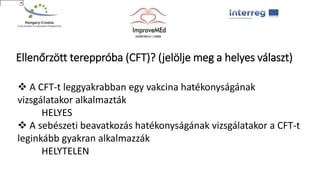
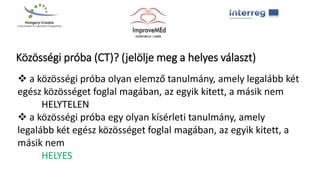
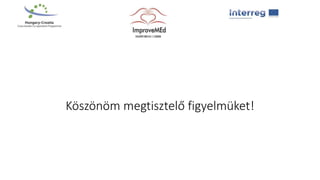
Ad
Recommended
2019 2020 predavanje letenje, ronjenje drenjancevic
2019 2020 predavanje letenje, ronjenje drenjancevicimprovemed
Ėý
Dokument se bavi fiziologijom letenja i ronjenja, istiÄuÄi utjecaj visine na zasiÄenje arterijske krvi kisikom te aklimatizacijskim procesima tijela na niske razine kisika. TakoÄer opisuje patofiziologiju bolesti povezanih s boravkom na velikim nadmorskim visinama i uÄinke hiperbariÄnih uvjeta, ukljuÄujuÄi toksiÄnost kisika i dekompresijsku bolest. Osim toga, raspravlja o fizioloÅĄkim problemima u besteÅūinskom stanju i izazovima tijekom svemirskih letova.In vitro models of hepatotoxicity
In vitro models of hepatotoxicityimprovemed
Ėý
This document describes various in vitro models and methods that can be used to study hepatotoxicity, including hepatocyte cell cultures, assays to measure cell viability and metabolic activity (trypan blue dye exclusion test, MTT assay), staining to visualize lipid accumulation (Oil Red O), and techniques to examine gene and protein expression changes (RT-PCR, western blotting). Specifically, it discusses using these methods to establish models of non-alcoholic fatty liver disease (NAFLD) by treating hepatocyte cultures with fatty acids like palmitic and oleic acid, and models of drug-induced hepatotoxicity by treating with acetaminophen or amiodarone. Key readouts include lipid accumulation, apoptosis levelsEtiology of liver diseases
Etiology of liver diseasesimprovemed
Ėý
This document summarizes various liver diseases and their etiologies. It discusses alcoholic liver disease, drug-induced liver injury, viral hepatitis infections from hepatitis B, C, and D viruses, autoimmune disorders like autoimmune hepatitis and primary biliary cirrhosis, genetic disorders, non-alcoholic fatty liver disease, cirrhosis, and hepatocellular carcinoma. The liver's important functions are outlined. Causes, pathogenesis, clinical features, diagnosis, and treatment approaches are described for each disease.An introduction to experimental epidemiology
An introduction to experimental epidemiology improvemed
Ėý
This document provides an overview of experimental epidemiology methods. It discusses the key features and types of experimental epidemiology studies, including controlled field trials and community trials. Controlled field trials involve dividing healthy subjects into an exposed group that receives an active substance (like a vaccine) and an unexposed control group that receives a placebo. Community trials involve entire exposed and unexposed communities. Randomized controlled trials, which assign individual subjects randomly to intervention or control groups, are described as the most common experimental method but are covered in more depth separately. Overall, the document outlines the design and purpose of various experimental epidemiology study types.Genotyping methods of nosocomial infections pathogen
Genotyping methods of nosocomial infections pathogenimprovemed
Ėý
Nosocomial infections afflict around 2 million patients in the US each year, resulting in around 88,000 deaths and $4.5 billion in excess healthcare costs. Understanding the distribution and relatedness of pathogens that cause these infections is important for designing effective control methods. Historically, phenotypic characterization was used, but increasingly molecular or genotyping techniques are being used, including pulsed-field gel electrophoresis, multilocus sequence typing, and polymerase chain reaction-based methods. Studies have shown that integrating molecular typing into infection control programs can significantly reduce infection rates and healthcare costs.Use of MALDI-TOF in the diagnosis of infectious diseases
Use of MALDI-TOF in the diagnosis of infectious diseasesimprovemed
Ėý
MALDI-TOF MS has revolutionized clinical microbiology by drastically improving the time needed to identify bacterial cultures from over 24 hours to just a few minutes. Whereas the entire process from sampling to results previously took 2-3 days or more, new methods like MALDI-TOF MS and molecular technology have reduced this to just a few hours or one day. MALDI-TOF MS is a powerful, cost-effective, and easy to implement technique that provides rapid and reliable identification of bacteria and yeast from clinical samples at the genus and species level through analysis of their protein mass spectral signatures.Molecular microbiology methods
Molecular microbiology methodsimprovemed
Ėý
1. Molecular microbiology methods like PCR and hybridization have revolutionized clinical diagnostics by enabling fast and direct detection of pathogens from clinical samples.
2. PCR in particular has become a mainstay technique, allowing amplification of specific DNA sequences from small amounts of input DNA. Variations like real-time PCR, multiplex PCR, and broad-range PCR further expanded diagnostic capabilities.
3. Emerging technologies like DNA microarrays promise even greater multiplexing, with the ability to simultaneously genotype large genomic regions or measure expression of many genes, positioning them as promising future molecular diagnostic tools.Isolated vascular rings
Isolated vascular ringsimprovemed
Ėý
This document provides information about setting up and conducting experiments with isolated organs and tissue rings, including:
1. Describing the mechanical setup for a four-channel system bath for isolated organs.
2. Explaining the preparation of Krebs-Hanseleit solution and common drugs used.
3. Outlining typical experiment protocols, including stabilizing tissues, pre-contraction testing, and assessing endothelial function.
4. Noting that each experiment begins by preparing Krebs-Hanseleit solution and activating the system before surgery and setting rings in wells.Isolated blood vessels
Isolated blood vesselsimprovemed
Ėý
This document describes the components, work principles, and experimental protocols for using a pressure myograph system to study isolated blood vessels. The system allows measuring vessel diameter in response to drugs and stimuli while maintaining constant temperature. Experiments involve isolating small arteries from rats and attaching them to glass micropipettes in a chamber filled with physiological salt solution. Vessel diameter is recorded under varying pressures and drug exposures to study endothelial function and vasoactive mechanisms. Statistical analysis of diameter changes under different conditions uses repeated measures ANOVA to compare responses between experimental groups.Notes for Measuring blood flow and reactivity of the blood vessels in the ski...
Notes for Measuring blood flow and reactivity of the blood vessels in the ski...improvemed
Ėý
This document describes the laser Doppler flowmetry (LDF) method for measuring blood flow in the microcirculation of skin. Specifically, it discusses post-occlusive reactive hyperemia (PORH) testing using LDF to assess microvascular reactivity by inducing a brief occlusion of blood vessels. It also covers iontophoresis of acetylcholine and sodium nitroprusside combined with LDF to evaluate endothelium-dependent and independent vasodilation respectively. Standardization of methods like occlusion duration and probe placement is important for reproducibility. LDF provides a general index of microvascular function rather than direct flow measurements.Notes for STAINING AND ANALYSIS of HISTOLOGICAL PREPARATIONS
Notes for STAINING AND ANALYSIS of HISTOLOGICAL PREPARATIONSimprovemed
Ėý
This document provides an overview of histological staining techniques. It discusses how histological preparations are stained using interactions between dyes, solvents, and tissue components. Different staining methods result in different colors that highlight various structures. A classic example is hematoxylin and eosin staining, where hematoxylin stains acidic components blue and eosin stains basic components pink. Specialized staining techniques also exist, such as immunohistochemistry. Proper staining selection depends on the tissue and research goals. Histological preparations are then analyzed under a microscope to study cell and tissue morphology.Notes for Fixation of tissues and organs for educational and scientific purposes
Notes for Fixation of tissues and organs for educational and scientific purposesimprovemed
Ėý
Fixation of tissues and organs is done to preserve them for scientific and educational purposes. Various chemical fixatives are used including formaldehyde, alcohols, and acids. Formaldehyde cross-links proteins to harden the tissue while maintaining the original structure. Several fixation protocols are used for different purposes, balancing preservation of color and long-term durability. Key steps include diffusion or injection of fixatives, followed by storage in preservative solutions. Proper fixation and storage are necessary to prevent degradation over time.Notes for
Notes for improvemed
Ėý
The document summarizes the process of preparing tissue samples for histological analysis, including fixation, dehydration, infiltration/embedding, sectioning, staining, and examination. Key steps involve fixing tissues to prevent degradation, dehydrating using increasing alcohol concentrations, infiltrating with paraffin wax or resin for structural support during sectioning, precisely cutting thin sections, mounting them to glass slides, staining, and examining under a microscope. The quality of prepared samples depends on carefully following each step of the preparation process.Notes for The principle and performance of capillary electrophoresis
Notes for The principle and performance of capillary electrophoresisimprovemed
Ėý
This document provides an overview of capillary electrophoresis (CE). It begins by introducing CE and its advantages over other separation techniques. It then describes the basic theory behind CE, including electrophoretic mobility, electroosmotic flow, and how samples migrate through the capillary when an electric field is applied. The document details the key components of a CE instrument and various CE separation techniques such as capillary zone electrophoresis, micellar electrokinetic chromatography, and capillary isoelectric focusing. It focuses on the principles and applications of CE.Notes for The principle and performance of liquid chromatographyâmass spectro...
Notes for The principle and performance of liquid chromatographyâmass spectro...improvemed
Ėý
This document provides an overview of liquid chromatography-mass spectrometry (LC-MS). It describes the basic components and functioning of an LC-MS system, including the liquid chromatograph and mass spectrometer connected by an interface. The document discusses various ionization sources like electrospray ionization and atmospheric pressure chemical ionization, as well as mass analyzers like quadrupoles and time-of-flight analyzers. It also covers detectors used in LC-MS like electron multipliers and photomultipliers. Overall, the document serves as a technical introduction to the principles and components of LC-MS.Notes for Cell Culture Basic Techniques
Notes for Cell Culture Basic Techniquesimprovemed
Ėý
This document provides an overview of basic cell culture techniques. It discusses the history of cell culture, defining primary and secondary cell cultures. It describes different types of cell lines and how cells grow as monolayers or in suspension. The document outlines the key equipment needed for a cell culture laboratory, including biosafety cabinets, CO2 incubators, centrifuges, microscopes, and supplies. It emphasizes the importance of aseptic technique to prevent microbial contamination when working with cell cultures.Big datasets
Big datasetsimprovemed
Ėý
This document discusses systems biology and its goals of understanding how biological molecules interact and systems function as a whole. It covers:
1) Systems biology uses large datasets from "omics" experiments and computational models to understand complex biological interactions beyond individual molecules.
2) Pioneering work used microarrays to measure thousands of genes in serum-stimulated cells, finding over 500 changed in proliferation.
3) The field aims to discover emergent system properties and functions not evident from separate parts, like switches that change cell behavior.Systems biology for Medicine' is 'Experimental methods and the big datasets
Systems biology for Medicine' is 'Experimental methods and the big datasetsimprovemed
Ėý
This document discusses experimental methods used in systems biology to generate large datasets, including microarrays, sequencing-based methods, mass spectrometry, and liquid chromatography. It explains that systems biology studies must be quantitative and enable computational modeling. Key methods covered are microarrays, RNA-seq, ChIP-seq, whole-genome sequencing, whole-exome sequencing, proteomics using mass spectrometry, and combining liquid chromatography with mass spectrometry for lipidomics, metabolomics and glycomics. Sources of variation are also discussed for genomic and proteomic studies.Systems biology for medical students/Systems medicine
Systems biology for medical students/Systems medicineimprovemed
Ėý
Systems biology takes a holistic approach to studying biological systems by considering all the interactions within a system and how they generate complex behaviors. Lecture 1 introduces key concepts in systems biology like how increasing levels of biological organization give rise to new system properties like robustness. Lecture 2 discusses experimental methods like genomics, proteomics, and metabolomics that generate large data sets for systems analysis. Lecture 3 covers mathematical and statistical tools for analyzing these data sets, such as using differential equations to model signaling networks. Lecture 4 provides examples of medical applications of systems biology in finding diagnostic markers, personalizing therapy, and predicting disease interactions from human disease networks, with the future of medicine taking a more predictive, preventive, and personalized approachUse cases
Use casesimprovemed
Ėý
The document discusses several use cases for applying data mining and machine learning techniques in healthcare and biomedical research. Three examples are:
1) Early diagnosis of cancers like lung cancer and breast cancer through predictive modeling of patient data to detect cancers at earlier stages when survival rates are higher.
2) Predicting patient responses to drug therapies for cancers like breast cancer by combining different types of molecular profiling data using techniques like support vector machines and random forests.
3) Using imaging data and temporal analysis of metrics like medication purchases to better understand and predict chronic diseases like diabetes and associated health complications.Basic course for computer based methods
Basic course for computer based methodsimprovemed
Ėý
The document discusses various data mining methods. It describes data mining as seeking patterns within large databases. Common data mining methods mentioned include clustering, regression, rule extraction, and data visualization. Machine learning algorithms often used for health data include logistic regression, support vector machines, decision trees, and neural networks. The document also discusses newer techniques like graph-based data mining, topological data mining, and data visualization for exploring complex data.Medicine as data science
Medicine as data scienceimprovemed
Ėý
This document discusses biomedical informatics and the increasing role of data in medicine. It notes that medicine is becoming a more data-intensive field due to growing sources of electronic health data. Biomedical data is often large in volume, diverse, complex, weakly structured, noisy, and inconsistent. Extracting knowledge from this "big data" through techniques like data mining, machine learning, and integrating human-computer interaction can provide insights to improve healthcare outcomes. Key applications include personalized and predictive medicine through patient stratification and risk analysis. However, overcoming obstacles like heterogeneous and non-standardized data is challenging.Basic Immunology 21 26
Basic Immunology 21 26improvemed
Ėý
This document discusses hypersensitivity reactions and autoimmune diseases. It describes the four types of hypersensitivity reactions according to the Gell and Coombs classification: Type I (immediate), Type II (cytotoxic), Type III (immune complex-mediated), and Type IV (delayed type hypersensitivity). It provides details on the mechanisms and examples of each type. The document then discusses immunological tolerance, including central and peripheral tolerance. It explains how a breakdown in tolerance can lead to autoimmune diseases and provides examples like Graves' disease, myasthenia gravis, hemolytic anemia, and systemic lupus erythematosus.Basic Immunology 11-20
Basic Immunology 11-20improvemed
Ėý
The document discusses lymphocyte development and antigen receptor gene rearrangement. It covers the following key points:
1. Lymphocyte development involves commitment to the B or T cell lineage, proliferation of progenitors, rearrangement of antigen receptor genes, selection checkpoints, and differentiation into distinct subpopulations.
2. B cells undergo gene rearrangement and development in the bone marrow before migrating to peripheral lymphoid organs. T cells develop through similar processes in the thymus.
3. During development, gene rearrangement generates diversity in antigen receptor genes, and selection checkpoints ensure that only lymphocytes with functional receptors will mature and enter the peripheral immune system.Basic immunology 1 10
Basic immunology 1 10improvemed
Ėý
This document provides an overview of basic immunology concepts. It begins with definitions of key immunology terms like immunity, immunology, antigen, and discusses the historical figures Edward Jenner and Louis Pasteur who were pioneers in vaccination. It then discusses the components of the immune system including organs like the bone marrow, thymus, lymph nodes, and spleen. It provides information on cells of the immune system like antigen presenting cells, T and B lymphocytes, and effector cells. It also discusses molecular components of antigen recognition including antibodies, T cell receptors, B cell receptors, and the major histocompatibility complex.Primjeri upotrebe
Primjeri upotrebeimprovemed
Ėý
Dokument se bavi primjenom biomedicinske informatike u ranom otkrivanju raka, predikciji terapijskih odgovora i koriÅĄtenju dijagnostiÄkih alata za kroniÄne bolesti. Razvijaju se tehnike poput analize podataka i omics pristupa za poboljÅĄanje dijagnoze i razumijevanja bolesti, ukljuÄujuÄi istraÅūivanja ljudskog mikrobioma i inovacije u razvoju cjepiva. TakoÄer se razmatraju vremenske analize serija za predviÄanje zdravstvenih ishoda, posebno u kontekstu dijabetesa.Osnovni teÄaj raÄunalnih metoda
Osnovni teÄaj raÄunalnih metoda improvemed
Ėý
Dokument opisuje metode rudarenja podataka (data mining) koje kombiniraju umjetnu inteligenciju, strojno uÄenje i statistiku za analizu velikih skupova podataka, posebno u zdravstvenim znanostima. Istaknute su razliÄite tehnike poput klasteriranja, logistiÄke regresije i umjetnih neuronskih mreÅūa, te njihova primjena u predikciji i klasifikaciji podataka. TakoÄer se raspravlja o vaÅūnosti vizualizacije podataka za bolje razumijevanje sloÅūenosti informacija.Medicina kao znanost podataka
Medicina kao znanost podatakaimprovemed
Ėý
Dokument se fokusira na razvoj biomedicinske informatike i kako veliki podaci transformiraju medicinu putem digitalizacije, analize i nove pristupa personaliziranoj medicini. IstiÄe izazove s heterogenim podacima, potrebom za integracijom i analizi te vaÅūnost znanja koja se moÅūe izvuÄi iz tih podataka za poboljÅĄanje zdravstvenih ishoda. TakoÄer se raspravlja o ulozi strojnog uÄenja i metoda otkrivanja podataka u zdravstvenoj praksi.Dynamic Physical Education For Secondary School Students 7th Edition Darst Te...
Dynamic Physical Education For Secondary School Students 7th Edition Darst Te...lpzrvlk486
Ėý
Dynamic Physical Education For Secondary School Students 7th Edition Darst Test Bank
Dynamic Physical Education For Secondary School Students 7th Edition Darst Test Bank
Dynamic Physical Education For Secondary School Students 7th Edition Darst Test BankThe Tools of Government: A Guide to the New Governance 1st Edition
The Tools of Government: A Guide to the New Governance 1st Editionkaubxurs1992
Ėý
The Tools of Government: A Guide to the New Governance 1st Edition
The Tools of Government: A Guide to the New Governance 1st Edition
The Tools of Government: A Guide to the New Governance 1st EditionMore Related Content
More from improvemed (20)
Isolated blood vessels
Isolated blood vesselsimprovemed
Ėý
This document describes the components, work principles, and experimental protocols for using a pressure myograph system to study isolated blood vessels. The system allows measuring vessel diameter in response to drugs and stimuli while maintaining constant temperature. Experiments involve isolating small arteries from rats and attaching them to glass micropipettes in a chamber filled with physiological salt solution. Vessel diameter is recorded under varying pressures and drug exposures to study endothelial function and vasoactive mechanisms. Statistical analysis of diameter changes under different conditions uses repeated measures ANOVA to compare responses between experimental groups.Notes for Measuring blood flow and reactivity of the blood vessels in the ski...
Notes for Measuring blood flow and reactivity of the blood vessels in the ski...improvemed
Ėý
This document describes the laser Doppler flowmetry (LDF) method for measuring blood flow in the microcirculation of skin. Specifically, it discusses post-occlusive reactive hyperemia (PORH) testing using LDF to assess microvascular reactivity by inducing a brief occlusion of blood vessels. It also covers iontophoresis of acetylcholine and sodium nitroprusside combined with LDF to evaluate endothelium-dependent and independent vasodilation respectively. Standardization of methods like occlusion duration and probe placement is important for reproducibility. LDF provides a general index of microvascular function rather than direct flow measurements.Notes for STAINING AND ANALYSIS of HISTOLOGICAL PREPARATIONS
Notes for STAINING AND ANALYSIS of HISTOLOGICAL PREPARATIONSimprovemed
Ėý
This document provides an overview of histological staining techniques. It discusses how histological preparations are stained using interactions between dyes, solvents, and tissue components. Different staining methods result in different colors that highlight various structures. A classic example is hematoxylin and eosin staining, where hematoxylin stains acidic components blue and eosin stains basic components pink. Specialized staining techniques also exist, such as immunohistochemistry. Proper staining selection depends on the tissue and research goals. Histological preparations are then analyzed under a microscope to study cell and tissue morphology.Notes for Fixation of tissues and organs for educational and scientific purposes
Notes for Fixation of tissues and organs for educational and scientific purposesimprovemed
Ėý
Fixation of tissues and organs is done to preserve them for scientific and educational purposes. Various chemical fixatives are used including formaldehyde, alcohols, and acids. Formaldehyde cross-links proteins to harden the tissue while maintaining the original structure. Several fixation protocols are used for different purposes, balancing preservation of color and long-term durability. Key steps include diffusion or injection of fixatives, followed by storage in preservative solutions. Proper fixation and storage are necessary to prevent degradation over time.Notes for
Notes for improvemed
Ėý
The document summarizes the process of preparing tissue samples for histological analysis, including fixation, dehydration, infiltration/embedding, sectioning, staining, and examination. Key steps involve fixing tissues to prevent degradation, dehydrating using increasing alcohol concentrations, infiltrating with paraffin wax or resin for structural support during sectioning, precisely cutting thin sections, mounting them to glass slides, staining, and examining under a microscope. The quality of prepared samples depends on carefully following each step of the preparation process.Notes for The principle and performance of capillary electrophoresis
Notes for The principle and performance of capillary electrophoresisimprovemed
Ėý
This document provides an overview of capillary electrophoresis (CE). It begins by introducing CE and its advantages over other separation techniques. It then describes the basic theory behind CE, including electrophoretic mobility, electroosmotic flow, and how samples migrate through the capillary when an electric field is applied. The document details the key components of a CE instrument and various CE separation techniques such as capillary zone electrophoresis, micellar electrokinetic chromatography, and capillary isoelectric focusing. It focuses on the principles and applications of CE.Notes for The principle and performance of liquid chromatographyâmass spectro...
Notes for The principle and performance of liquid chromatographyâmass spectro...improvemed
Ėý
This document provides an overview of liquid chromatography-mass spectrometry (LC-MS). It describes the basic components and functioning of an LC-MS system, including the liquid chromatograph and mass spectrometer connected by an interface. The document discusses various ionization sources like electrospray ionization and atmospheric pressure chemical ionization, as well as mass analyzers like quadrupoles and time-of-flight analyzers. It also covers detectors used in LC-MS like electron multipliers and photomultipliers. Overall, the document serves as a technical introduction to the principles and components of LC-MS.Notes for Cell Culture Basic Techniques
Notes for Cell Culture Basic Techniquesimprovemed
Ėý
This document provides an overview of basic cell culture techniques. It discusses the history of cell culture, defining primary and secondary cell cultures. It describes different types of cell lines and how cells grow as monolayers or in suspension. The document outlines the key equipment needed for a cell culture laboratory, including biosafety cabinets, CO2 incubators, centrifuges, microscopes, and supplies. It emphasizes the importance of aseptic technique to prevent microbial contamination when working with cell cultures.Big datasets
Big datasetsimprovemed
Ėý
This document discusses systems biology and its goals of understanding how biological molecules interact and systems function as a whole. It covers:
1) Systems biology uses large datasets from "omics" experiments and computational models to understand complex biological interactions beyond individual molecules.
2) Pioneering work used microarrays to measure thousands of genes in serum-stimulated cells, finding over 500 changed in proliferation.
3) The field aims to discover emergent system properties and functions not evident from separate parts, like switches that change cell behavior.Systems biology for Medicine' is 'Experimental methods and the big datasets
Systems biology for Medicine' is 'Experimental methods and the big datasetsimprovemed
Ėý
This document discusses experimental methods used in systems biology to generate large datasets, including microarrays, sequencing-based methods, mass spectrometry, and liquid chromatography. It explains that systems biology studies must be quantitative and enable computational modeling. Key methods covered are microarrays, RNA-seq, ChIP-seq, whole-genome sequencing, whole-exome sequencing, proteomics using mass spectrometry, and combining liquid chromatography with mass spectrometry for lipidomics, metabolomics and glycomics. Sources of variation are also discussed for genomic and proteomic studies.Systems biology for medical students/Systems medicine
Systems biology for medical students/Systems medicineimprovemed
Ėý
Systems biology takes a holistic approach to studying biological systems by considering all the interactions within a system and how they generate complex behaviors. Lecture 1 introduces key concepts in systems biology like how increasing levels of biological organization give rise to new system properties like robustness. Lecture 2 discusses experimental methods like genomics, proteomics, and metabolomics that generate large data sets for systems analysis. Lecture 3 covers mathematical and statistical tools for analyzing these data sets, such as using differential equations to model signaling networks. Lecture 4 provides examples of medical applications of systems biology in finding diagnostic markers, personalizing therapy, and predicting disease interactions from human disease networks, with the future of medicine taking a more predictive, preventive, and personalized approachUse cases
Use casesimprovemed
Ėý
The document discusses several use cases for applying data mining and machine learning techniques in healthcare and biomedical research. Three examples are:
1) Early diagnosis of cancers like lung cancer and breast cancer through predictive modeling of patient data to detect cancers at earlier stages when survival rates are higher.
2) Predicting patient responses to drug therapies for cancers like breast cancer by combining different types of molecular profiling data using techniques like support vector machines and random forests.
3) Using imaging data and temporal analysis of metrics like medication purchases to better understand and predict chronic diseases like diabetes and associated health complications.Basic course for computer based methods
Basic course for computer based methodsimprovemed
Ėý
The document discusses various data mining methods. It describes data mining as seeking patterns within large databases. Common data mining methods mentioned include clustering, regression, rule extraction, and data visualization. Machine learning algorithms often used for health data include logistic regression, support vector machines, decision trees, and neural networks. The document also discusses newer techniques like graph-based data mining, topological data mining, and data visualization for exploring complex data.Medicine as data science
Medicine as data scienceimprovemed
Ėý
This document discusses biomedical informatics and the increasing role of data in medicine. It notes that medicine is becoming a more data-intensive field due to growing sources of electronic health data. Biomedical data is often large in volume, diverse, complex, weakly structured, noisy, and inconsistent. Extracting knowledge from this "big data" through techniques like data mining, machine learning, and integrating human-computer interaction can provide insights to improve healthcare outcomes. Key applications include personalized and predictive medicine through patient stratification and risk analysis. However, overcoming obstacles like heterogeneous and non-standardized data is challenging.Basic Immunology 21 26
Basic Immunology 21 26improvemed
Ėý
This document discusses hypersensitivity reactions and autoimmune diseases. It describes the four types of hypersensitivity reactions according to the Gell and Coombs classification: Type I (immediate), Type II (cytotoxic), Type III (immune complex-mediated), and Type IV (delayed type hypersensitivity). It provides details on the mechanisms and examples of each type. The document then discusses immunological tolerance, including central and peripheral tolerance. It explains how a breakdown in tolerance can lead to autoimmune diseases and provides examples like Graves' disease, myasthenia gravis, hemolytic anemia, and systemic lupus erythematosus.Basic Immunology 11-20
Basic Immunology 11-20improvemed
Ėý
The document discusses lymphocyte development and antigen receptor gene rearrangement. It covers the following key points:
1. Lymphocyte development involves commitment to the B or T cell lineage, proliferation of progenitors, rearrangement of antigen receptor genes, selection checkpoints, and differentiation into distinct subpopulations.
2. B cells undergo gene rearrangement and development in the bone marrow before migrating to peripheral lymphoid organs. T cells develop through similar processes in the thymus.
3. During development, gene rearrangement generates diversity in antigen receptor genes, and selection checkpoints ensure that only lymphocytes with functional receptors will mature and enter the peripheral immune system.Basic immunology 1 10
Basic immunology 1 10improvemed
Ėý
This document provides an overview of basic immunology concepts. It begins with definitions of key immunology terms like immunity, immunology, antigen, and discusses the historical figures Edward Jenner and Louis Pasteur who were pioneers in vaccination. It then discusses the components of the immune system including organs like the bone marrow, thymus, lymph nodes, and spleen. It provides information on cells of the immune system like antigen presenting cells, T and B lymphocytes, and effector cells. It also discusses molecular components of antigen recognition including antibodies, T cell receptors, B cell receptors, and the major histocompatibility complex.Primjeri upotrebe
Primjeri upotrebeimprovemed
Ėý
Dokument se bavi primjenom biomedicinske informatike u ranom otkrivanju raka, predikciji terapijskih odgovora i koriÅĄtenju dijagnostiÄkih alata za kroniÄne bolesti. Razvijaju se tehnike poput analize podataka i omics pristupa za poboljÅĄanje dijagnoze i razumijevanja bolesti, ukljuÄujuÄi istraÅūivanja ljudskog mikrobioma i inovacije u razvoju cjepiva. TakoÄer se razmatraju vremenske analize serija za predviÄanje zdravstvenih ishoda, posebno u kontekstu dijabetesa.Osnovni teÄaj raÄunalnih metoda
Osnovni teÄaj raÄunalnih metoda improvemed
Ėý
Dokument opisuje metode rudarenja podataka (data mining) koje kombiniraju umjetnu inteligenciju, strojno uÄenje i statistiku za analizu velikih skupova podataka, posebno u zdravstvenim znanostima. Istaknute su razliÄite tehnike poput klasteriranja, logistiÄke regresije i umjetnih neuronskih mreÅūa, te njihova primjena u predikciji i klasifikaciji podataka. TakoÄer se raspravlja o vaÅūnosti vizualizacije podataka za bolje razumijevanje sloÅūenosti informacija.Medicina kao znanost podataka
Medicina kao znanost podatakaimprovemed
Ėý
Dokument se fokusira na razvoj biomedicinske informatike i kako veliki podaci transformiraju medicinu putem digitalizacije, analize i nove pristupa personaliziranoj medicini. IstiÄe izazove s heterogenim podacima, potrebom za integracijom i analizi te vaÅūnost znanja koja se moÅūe izvuÄi iz tih podataka za poboljÅĄanje zdravstvenih ishoda. TakoÄer se raspravlja o ulozi strojnog uÄenja i metoda otkrivanja podataka u zdravstvenoj praksi.Recently uploaded (9)
Dynamic Physical Education For Secondary School Students 7th Edition Darst Te...
Dynamic Physical Education For Secondary School Students 7th Edition Darst Te...lpzrvlk486
Ėý
Dynamic Physical Education For Secondary School Students 7th Edition Darst Test Bank
Dynamic Physical Education For Secondary School Students 7th Edition Darst Test Bank
Dynamic Physical Education For Secondary School Students 7th Edition Darst Test BankThe Tools of Government: A Guide to the New Governance 1st Edition
The Tools of Government: A Guide to the New Governance 1st Editionkaubxurs1992
Ėý
The Tools of Government: A Guide to the New Governance 1st Edition
The Tools of Government: A Guide to the New Governance 1st Edition
The Tools of Government: A Guide to the New Governance 1st EditionEssentials of Nursing Leadership and Management 6th edition Weiss Test Bank
Essentials of Nursing Leadership and Management 6th edition Weiss Test Bankxxricnxvze853
Ėý
Essentials of Nursing Leadership and Management 6th edition Weiss Test Bank
Essentials of Nursing Leadership and Management 6th edition Weiss Test Bank
Essentials of Nursing Leadership and Management 6th edition Weiss Test BankOutreach Works Strategies for Expanding Health Access in Communities Michael ...
Outreach Works Strategies for Expanding Health Access in Communities Michael ...azhxpcuhh1521
Ėý
Outreach Works Strategies for Expanding Health Access in Communities Michael Dechiara
Outreach Works Strategies for Expanding Health Access in Communities Michael Dechiara
Outreach Works Strategies for Expanding Health Access in Communities Michael DechiaraSuccessful Project Management 7th Edition Gido Test Bank
Successful Project Management 7th Edition Gido Test Bankcezmbtdj268
Ėý
Successful Project Management 7th Edition Gido Test Bank
Successful Project Management 7th Edition Gido Test Bank
Successful Project Management 7th Edition Gido Test BankTest Bank for Managing Organizational Behavior, 2nd Edition: Timothy Baldwin
Test Bank for Managing Organizational Behavior, 2nd Edition: Timothy Baldwincekxmus0952
Ėý
Test Bank for Managing Organizational Behavior, 2nd Edition: Timothy Baldwin
Test Bank for Managing Organizational Behavior, 2nd Edition: Timothy Baldwin
Test Bank for Managing Organizational Behavior, 2nd Edition: Timothy BaldwinThe Handbook of Media and Mass Communication Theory 2 Volume Set 1st Edition ...
The Handbook of Media and Mass Communication Theory 2 Volume Set 1st Edition ...veinbdkhyy9982
Ėý
The Handbook of Media and Mass Communication Theory 2 Volume Set 1st Edition Robert S. Fortner
The Handbook of Media and Mass Communication Theory 2 Volume Set 1st Edition Robert S. Fortner
The Handbook of Media and Mass Communication Theory 2 Volume Set 1st Edition Robert S. FortnerUnderstanding Management 9th Edition Daft Solutions Manual
Understanding Management 9th Edition Daft Solutions Manuallqlgbxbdhr923
Ėý
Understanding Management 9th Edition Daft Solutions Manual
Understanding Management 9th Edition Daft Solutions Manual
Understanding Management 9th Edition Daft Solutions ManualFinancial and Managerial Accounting The Basis for Business Decisions 18th Edi...
Financial and Managerial Accounting The Basis for Business Decisions 18th Edi...jawrzehm5338
Ėý
Financial and Managerial Accounting The Basis for Business Decisions 18th Edition Williams Test Bank
Financial and Managerial Accounting The Basis for Business Decisions 18th Edition Williams Test Bank
Financial and Managerial Accounting The Basis for Business Decisions 18th Edition Williams Test BankAd
KÃsÃĐrleti epidemiolÃģgiai mÃģdszerek
- 1. KÃsÃĐrleti epidemiolÃģgiai mÃģdszerek Professor Maja Miskulin, MD, PhD
- 2. TÃķrtÃĐnelem ïķJames Lind â 1747. az egyik elsÅ, kontrollÃĄlt klinikai kÃsÃĐrlet az orvostudomÃĄnyban
- 3. KÃsÃĐrleti vizsgÃĄlatok ïķ zavarÃģ tÃĐnyezÅk ÃĄltalÃĄban nem jelentenek problÃĐmÃĄt a kÃsÃĐrleti vizsgÃĄlatokban ïķ az epidemiolÃģgusok ÃĄltalÃĄban az emberi populÃĄciÃģkat tanulmÃĄnyozzÃĄk (fÅkÃĐnt megfigyelÃĐsit) ïķ A kÃsÃĐrleti vizsgÃĄlatokat nagyrÃĐszt az orvosi alaptudomÃĄnyokban hasznÃĄljÃĄk, ahol a kutatÃģk ÃĄllatkÃsÃĐrleteket terveznek
- 4. KÃsÃĐrleti vizsgÃĄlatok ïķ a kÃsÃĐrleti vizsgÃĄlatok sorÃĄn a vizsgÃĄlatot vÃĐgzÅ szemÃĐlynek âellenÅrzÃĐseâ van a vizsgÃĄlati tÃĐnyezÅ felett ïķ a kutatÃģ meghatÃĄrozza, hogy a vizsgÃĄlt alanyok melyik hatÃģanyagot kapjÃĄk, ÃĐs ki nem kap hatÃģanyagot ïķ a kontrollcsoport a placebÃģt vagy a piacon lÃĐtezÅ legjobb gyÃģgyszert kapja â az un. arany standardot
- 5. KÃsÃĐrleti vizsgÃĄlatok ïķ a vizsgÃĄlt csoportokban (a vizsgÃĄlt hatÃģanyagnak kitett ÃĐs annak nem kitett) a betegek osztÃĄlyozÃĄsÃĄnak legjobb mÃģdja a randomizÃĄciÃģ, ami jelzi a csoportok vÃĐletlenszerÅą eloszlÃĄsÃĄt a csoportokban ïķ A randomizÃĄciÃģt elsÅsorban a zavarÃģ tÃĐnyezÅk hatÃĄsainak kikÞszÃķbÃķlÃĐsÃĐre hasznÃĄljÃĄk
- 6. KÃsÃĐrleti vizsgÃĄlatok ïķ ha kÃsÃĐrleti vizsgÃĄlatokat alkalmazunk epidemiolÃģgiÃĄban, nagyon erÅs bizonyÃtÃĐkokat kaphatunk ïķ ezeket a vizsgÃĄlatokat nem szabad vÃĐgrehajtani addig, amÃg az ok-okozati vagy kockÃĄzati viszony valÃģszÃnÅąsÃĐgÃĐt nem megfelelÅen hatÃĄroztÃĄk meg a mÃĄs tÃpusÚ tanulmÃĄnyok alapjÃĄn
- 7. A kÃsÃĐrleti vizsgÃĄlatok tÃpusai ïķ randomizÃĄlt kontrollÃĄlt vizsgÃĄlat (RCT) ïķ ellenÅrzÃķtt terepprÃģba (CFT) ïķ kÃķzÃķssÃĐgi kiprÃģbÃĄlÃĄs (CT)
- 8. ïķ RandomizÃĄlt kontrollÃĄlt vizsgÃĄlat (RCT) ïķ Az RCT fÅ cÃĐlja az, hogy ÃĐrtÃĐkelje a terÃĄpiÃĄs megkÃķzelÃtÃĐst azoknÃĄl a betegeknÃĐl, akiket a vizsgÃĄlatban kÞlÃķn-kÞlÃķn vettek fel ïķ az RCT-ben a gyÃģgyszerek, a sebÃĐszeti eljÃĄrÃĄsok, bizonyos fizikai terÃĄpiÃĄs mÃģdszerek ÃĐs egyÃĐb terÃĄpiÃĄs mÃģdszerek hatÃĄsÃĄt vizsgÃĄlhatjuk
- 9. EllenÅrzÃķtt terepprÃģba (CFT) ïķ a CFT-ben a prevenciÃģs beavatkozÃĄsok leggyakrabban az egÃĐszsÃĐges egyÃĐnekre gyakorolt hatÃĄsÃĄt szeretnÃĐnk felmÃĐrni, amelyek egyenkÃĐnt szerepelnek a tanulmÃĄnyban ïķ A CFT-t leggyakrabban egy vakcina hatÃĐkonysÃĄgÃĄnak vizsgÃĄlatakor alkalmaztÃĄk
- 10. EllenÅrzÃķtt terepprÃģba (CFT) ïķ A Salk Polio Vaccine Field Trial - Jonas Salk 1957. februÃĄr 26-ÃĄn a Pittsburghi Egyetem aulÃĄjÃĄban polio (gyermekbÃĐnulÃĄs elleni) vÃĐdÅoltÃĄst adott be. A vakcinÃĄt Salk ÃĐs csapata hozta lÃĐtre gyermekbÃĐnulÃĄs
- 11. EllenÅrzÃķtt terepprÃģba (CFT) ïķ ellentÃĐtben az RCT-vel, a CFT leggyakrabban egÃĐszsÃĐges alanyokat tartalmaz, ÃĐs a mintavÃĐtelt a lakossÃĄgbÃģl vÃĐgzik ïķ a vakcina hatÃĐkonysÃĄgÃĄnak ÃĐs biztonsÃĄgossÃĄgÃĄnak vizsgÃĄlata sorÃĄn az egÃĐszsÃĐges szemÃĐlyeket kÃĐt csoportra kell osztanunk, az egyiket, amely megkapja a hatÃģanyagot (kitett csoport), a mÃĄsik pedig placebÃģt kap (nem expozÃciÃģs csoport)
- 12. EllenÅrzÃķtt terepprÃģba (CFT) ïķ ebben a kÃsÃĐrleti vizsgÃĄlatban tÃķbbfÃĐle mÃģdon is megjelenÃthetjÞk az eredmÃĐnyeket: ïķ relatÃv kockÃĄzat ïķ tÚlÃĐlÃĐsi gÃķrbÃĐk ïķ a vizsgÃĄlt vakcina hatÃĐkonysÃĄga (a populÃĄciÃģ megelÅzhetÅ frakciÃģjÃĄnak kiszÃĄmÃtÃĄsa - PPF)
- 13. A nÃĐpessÃĐgben megelÅzhetÅ rÃĐsze (PPF) ïķ elmondja, hogy a betegsÃĐg Újonnan diagnosztizÃĄlt eseteinek arÃĄnya a populÃĄciÃģ szintjÃĐn megelÅzhetÅ, ha a populÃĄciÃģban megelÅzÅ intÃĐzkedÃĐst alkalmazunk ðððđ % = ð 1 â ð ð ð 1 â ð ð + ð ð à 100 p â a vÃĐdÅfaktornak kitett lakossÃĄg arÃĄnya RR â relatÃv kockÃĄzat
- 14. KÃķzÃķssÃĐgi vizsgÃĄlatok (CT) ïķ a kÃķzÃķssÃĐgi prÃģba egy olyan kÃsÃĐrleti tanulmÃĄny, amely legalÃĄbb kÃĐt egÃĐsz kÃķzÃķssÃĐget foglal magÃĄban, az egyik kitett, a mÃĄsik nem kitett ïķ a vÃĐdÅfaktorok nÃĐmelyikÃĐt nem lehet vizsgÃĄlni az egyÃĐneknÃĐl, mert egy adott fÃķldrajzi terÞlet minden lakÃģja ki van tÃĐve ezeknek a tÃĐnyezÅknek
- 15. KÃķzÃķssÃĐgi vizsgÃĄlatok (CT) ïķ ebben az esetben a fÃķldrajzi terÞlet minden lakÃģja, amely vÃĐdÅfaktornak van kitÃĐve, szerepel a tanulmÃĄnyban, a kontroll csoportban egy mÃĄsik fÃķldrajzi terÞlet lakosai vannak, ahol ez a tÃĐnyezÅ hiÃĄnyzik
- 16. KÃķzÃķssÃĐgi vizsgÃĄlatok (CT) ïķ az egyik legismertebb kÃķzÃķssÃĐgi kÃsÃĐrlet 1944-ben kezdÅdÃķtt az EgyesÞlt Ãllamokban, amely a vÃz fluoridÃĄciÃģnak a fogak egÃĐszsÃĐgÃĐre gyakorolt ââhatÃĄsÃĄt vizsgÃĄlta gyermekeknÃĐl.
- 17. TermÃĐszeti kÃsÃĐrlet ïķ a termÃĐszeti kÃsÃĐrlet nem egy kÃsÃĐrletfajta ïķ a termÃĐszeti kÃsÃĐrlet kifejezÃĐs megfigyelÃĐsi epidemiolÃģgiai tanulmÃĄnyok esetÃĐben olyan szerencsÃĐtlen esemÃĐnyek vizsgÃĄlatÃĄt jelenti, mint a termÃĐszeti katasztrÃģfÃĄk (pl. ÃĄrvÃz, tÅąz vagy fÃķldrengÃĐs), vagy az emberi hibÃĄk ÃĐs gondatlansÃĄg okozta balesetek (pÃĐldÃĄul Csernobili katasztrÃģfa ÃĐs metil- higanymÃĐrgezÃĐs) a Minamata-ÃķbÃķlben JapÃĄnban)
- 18. KÃsÃĐrleti vizsgÃĄlat? (jelÃķlje meg a helyes vÃĄlaszt) ïķ a zavarÃģ tÃĐnyezÅk ÃĄltalÃĄban nagy problÃĐmÃĄt jelentenek a kÃsÃĐrleti vizsgÃĄlatokban Helytelen ïķ zavarÃģ tÃĐnyezÅk ÃĄltalÃĄban nem jelentenek problÃĐmÃĄt a kÃsÃĐrleti vizsgÃĄlatokban HELYES
- 19. EllenÅrzÃķtt terepprÃģba (CFT)? (jelÃķlje meg a helyes vÃĄlaszt) ïķ A CFT-t leggyakrabban egy vakcina hatÃĐkonysÃĄgÃĄnak vizsgÃĄlatakor alkalmaztÃĄk HELYES ïķ A sebÃĐszeti beavatkozÃĄs hatÃĐkonysÃĄgÃĄnak vizsgÃĄlatakor a CFT-t leginkÃĄbb gyakran alkalmazzÃĄk HELYTELEN AngolAngol
- 20. KÃķzÃķssÃĐgi prÃģba (CT)? (jelÃķlje meg a helyes vÃĄlaszt) ïķ a kÃķzÃķssÃĐgi prÃģba olyan elemzÅ tanulmÃĄny, amely legalÃĄbb kÃĐt egÃĐsz kÃķzÃķssÃĐget foglal magÃĄban, az egyik kitett, a mÃĄsik nem HELYTELEN ïķ a kÃķzÃķssÃĐgi prÃģba egy olyan kÃsÃĐrleti tanulmÃĄny, amely legalÃĄbb kÃĐt egÃĐsz kÃķzÃķssÃĐget foglal magÃĄban, az egyik kitett, a mÃĄsik nem HELYES